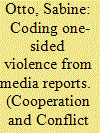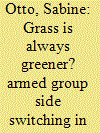| Srl | Item |
| 1 |
ID:
126802


|
|
|
|
|
| Publication |
2013.
|
| Summary/Abstract |
Event datasets on political violence, which are comprised of coded collected news reports, have enjoyed a renaissance within the academic community. The inclusion of civilian fatalities within these datasets is a promising and welcomed advancement regarding the availability of data on one-sided violence. However, these datasets are often criticised due to their heavy reliance on media records, which may be tainted by biases. So far, little attention has been paid to the specific problems that arise in the coding procedure with respect to one-sided violence. This article addresses such difficulties by discussing particular challenges presented by media biases and by providing empirical evidence from coding one-sided violence. Furthermore, solutions and strategies are offered to the issues that could affect the coding process, including increased transparency, definition-adaptation, and the use of appropriate statistical models.
|
|
|
|
|
|
|
|
|
|
|
|
|
|
|
|
| 2 |
ID:
160786


|
|
|
|
|
| Summary/Abstract |
Why do armed groups switch sides during civil wars? Most theories of conflict assume that armed groups have a fixed alignment with the government throughout their entire life span, ignoring the fact that armed groups switch between fighting on behalf of and against the government. In this article, I propose a theoretical framework that integrates armed groups’ willingness to switch sides and their capacity to do so. Armed groups are motivated to switch sides if it contributes to maintaining or improving organizational objectives. I therefore expect armed groups to switch sides as the number of other armed groups with the same alignment increases and when the state is weak. I also argue that armed groups require the capacity to switch sides in order to overcome the internal coordination problem. I propose that non-state armed actors that are the product of prior splintering are more homogeneous and cohesive than other groups. Hence, they are in a better position to attempt to switch sides. I test the propositions using a novel data set, the History of Armed Actors Dataset, containing data on when and where armed groups have switched sides during civil wars between 1989 and 2007. The results reveal that both incentives and capacity influence side switching.
|
|
|
|
|
|
|
|
|
|
|
|
|
|
|
|